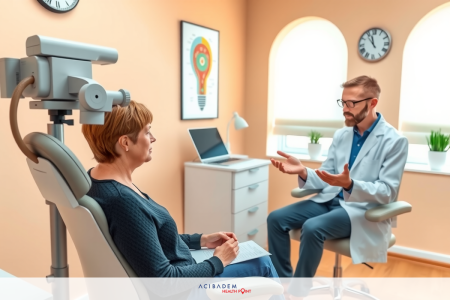Kawasaki Disease Eyes Symptoms & Visual Impact
Kawasaki Disease Eyes Symptoms & Visual Impact Kawasaki disease mostly hits kids and is an inflammatory condition. It can cause eye problems. Kids with Kawasaki disease may see redness and feel eye irritation early on. It’s key to catch these eye issues fast to protect a child’s sight. Groups like Acibadem Healthcare Group stress the need to know about Kawasaki disease eyes to act quickly.
Understanding Kawasaki Disease
Kawasaki disease is a condition that mainly affects kids. It’s a type of vasculitis, which means it inflames blood vessels. Kids with this disease often have a fever, rash, swollen hands and feet, mouth and throat issues, and swollen lymph nodes. It’s important to spot these symptoms early to get the right treatment.
- Fever: A high and persistent fever lasting more than five days.
- Rash: A polymorphous rash appearing on the body and limbs.
- Hand and Foot Effects: Swelling and redness in the palms and soles.
- Mouth and Throat Symptoms: Red, cracked lips, and a “strawberry tongue.”
- Lymph Nodes: Swollen lymph nodes, particularly in the neck.
We don’t know exactly why Kawasaki disease happens, but catching it early helps a lot. Doctors usually treat it with immunoglobulin and aspirin. These treatments help fight inflammation and prevent serious heart problems.
It’s important to know about Kawasaki disease because it’s a big deal for kids. With quick medical help and the right treatment, kids can avoid serious problems.
| Symptom | Description |
|---|---|
| Fever | High and persistent, lasting over five days. |
| Rash | Polymorphous, affecting body and limbs. |
| Swelling | Redness and swelling in the hands and feet. |
| Oral Symptoms | Red, cracked lips and “strawberry tongue.” |
| Swollen Lymph Nodes | Particularly noticeable in the neck area. |
Symptoms of Kawasaki Disease
Kawasaki disease in kids shows up with many symptoms. Kids may get a high fever that lasts over five days. This fever can cause inflammation in blood vessels, including the heart’s arteries.
Parents and doctors should watch for other signs of Kawasaki disease. These signs include:
- Extreme irritability, especially in young kids
- Skin peeling on the hands and feet, starting near the nails and fingers
- Swollen lymph nodes in the neck
- Red, cracked lips and a “strawberry” tongue
- Redness of the palms and soles
- Joint pain and swelling
- Gastrointestinal symptoms like diarrhea and belly pain
Spotting these signs early is very important. Doctors say knowing about them fast can help avoid serious heart problems.
Doctors use a checklist to spot Kawasaki disease early:
| Symptom | Details |
|---|---|
| Fever | Lasts more than five days |
| Rash | Often widespread with redness |
| Swollen hands and feet | Red, swollen and sometimes peeling skin |
| Conjunctivitis | Red eyes without discharge |
| Lymph node swelling | Particularly in the neck region |
Knowing and spotting these symptoms early helps manage Kawasaki disease in kids. It can prevent serious health problems later.
Eye Symptoms of Kawasaki Disease
Kawasaki disease is a serious illness that mostly affects young kids. It often shows eye symptoms. Spotting these signs early is key for quick and right treatment.
Conjunctivitis in Kawasaki Disease
Conjunctivitis is a common eye issue in Kawasaki disease. It makes both eyes red but doesn’t have discharge. This redness often shows up early, helping doctors spot the disease.
Other Eye-Related Symptoms
Other eye problems can also happen with Kawasaki disease. These include serious issues like uveitis. Uveitis can hurt vision if not caught early. Doctors who specialize in kids’ eyes are key in spotting these problems fast.
How Kawasaki Disease Affects Vision
Kawasaki disease can cause eye problems that need careful watching. Sometimes, it can hurt your vision a lot.
Potential Visual Complications
Kawasaki disease can cause uveitis, which makes the eyes inflamed and blurry. If not treated fast, it can harm your vision forever.
Long-Term Visual Impact
Kawasaki disease can have big effects on your vision over time. It might lead to glaucoma, cataracts, and even losing your sight. Watching children closely for any vision changes is very important.
Diagnosis of Kawasaki Disease
Doctors use several steps to diagnose Kawasaki disease. They start with a detailed look at the patient’s health history and a full physical check-up. This helps them spot important symptoms and rule out other illnesses.
Medical History and Initial Examination
The first step in diagnosing Kawasaki disease is checking the patient’s health history. Doctors look for signs like a high fever, skin rashes, and eye problems. This information is key to starting the right treatment.
Laboratory Tests and Imaging
Labs play a big part in making sure Kawasaki disease is diagnosed right. Doctors do blood tests to check for inflammation and odd white blood cell counts. They also use imaging like echocardiograms to see if the heart is affected.
These tests help doctors confirm the diagnosis, as explained by the American Heart Association. They make sure they have all the right information to diagnose correctly.
Treatment Options for Kawasaki Disease
The main goal of treating Kawasaki disease is to fight inflammation and protect the heart. This is key to keeping the heart healthy in those affected.
Medications
A common treatment for Kawasaki disease is giving high-dose intravenous immunoglobulin (IVIG). This is usually given in the first 10 days of the illness. IVIG helps by lowering fever and swelling by changing how the immune system works.
Aspirin therapy for Kawasaki disease is also often given with IVIG. High doses of aspirin help lower swelling and fever. Lower doses are used to stop blood clots.
Therapeutic Approaches
Other treatments are also important for managing Kawasaki disease. Doctors say starting treatment quickly is key to avoiding heart problems later. Quick action is crucial to lessen the chance of serious issues like big arteries in the heart.
| Treatment | Purpose |
|---|---|
| Intravenous immunoglobulin (IVIG) | Reduces inflammation and modulates the immune system |
| Aspirin therapy | Minimizes inflammation and fever; prevents blood clots |
| Early Intervention | Reduces risk of coronary artery complications |
Kawasaki Disease in Children
Kawasaki disease mostly hits kids and is the top cause of heart disease in them. It needs special care for the right diagnosis and treatment.
Prevalence and Demographics
The prevalence of Kawasaki disease changes around the world. It’s more common in Asian kids. In the U.S., it strikes about 20 out of 100,000 kids under 5 each year. Boys get it more often than girls.
Special Considerations for Pediatric Patients
Kids with Kawasaki disease need close watch for heart problems, like big arteries that can get weak. It’s also important to help them and their families feel less stressed. Doctors and nurses must be caring and give care that fits what kids need.
Good care for kids with Kawasaki disease is key. It helps lower the risks and helps kids get better.
Kawasaki Disease Rash and Other Symptoms
The rash from Kawasaki disease is often one of the first signs. It can look different on the body, even on the genital area. This rash is important for doctors to spot early.
Spotting Kawasaki disease symptoms quickly is key. Besides the rash, look for fever, swollen lymph nodes, and a red, swollen tongue called “strawberry tongue”. Peeling skin on hands and feet is also a sign.
Doctors must act fast when they see these signs. A rash and other symptoms mean it’s time to start treatment quickly. Knowing these signs helps doctors treat Kawasaki disease early, preventing serious problems later.
FAQ
What are the eye symptoms of Kawasaki disease?
Eye symptoms include redness and irritation without pus. Both eyes are often affected. Uveitis, an inflammation of the eye, can also happen. Early treatment is key to protect vision.
What is Kawasaki disease?
Kawasaki disease is a condition that affects kids. It causes fever, rash, swollen hands and feet, mouth pain, and swollen lymph nodes. The cause is still unknown, but treatment helps.
What are the symptoms of Kawasaki disease in children?
Kids with Kawasaki disease may feel very irritable and have a fever. They might also have a rash, peeling skin, joint pain, stomach issues, and swollen lymph nodes. Quick action is important to prevent heart problems.
What is conjunctivitis in Kawasaki disease?
Conjunctivitis in Kawasaki disease means the eyes are red and irritated but don't have pus. It usually affects both eyes and is one of the first signs.
Besides conjunctivitis, Kawasaki disease can cause uveitis. This is inflammation in the eye's middle layer. It's serious and needs quick treatment.
How does Kawasaki disease affect vision?
Most eye symptoms go away on their own. But, some cases can lead to serious vision problems. It's important to watch for any vision changes.
How is Kawasaki disease diagnosed?
Doctors look at the patient's history, do exams, and run tests. They might use echocardiograms to check the heart. The disease is diagnosed by looking for fever and four other symptoms, unless the heart is already affected.
What are the treatment options for Kawasaki disease?
Treatment aims to reduce inflammation and protect the heart. It usually includes high-dose IVIG therapy and aspirin. Starting treatment quickly is crucial to prevent heart damage.
How prevalent is Kawasaki disease in children?
Kawasaki disease is the top cause of heart disease in kids. It's more common in Asian kids. Doctors watch closely for heart problems and support the family.
What is the rash associated with Kawasaki disease?
The rash can look like redness all over, even on the genitals. It's one of the signs of Kawasaki disease, along with fever, swollen lymph nodes, mouth changes, and swollen hands and feet.













